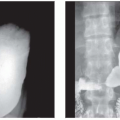Eventration and Paralysis of the Diaphragm
Michael P. Federle, MD, FACR
Mark M. Hammer, BS, MS
Key Facts
Imaging
Eventration: Diaphragm muscle is thinned and permanently elevated but retains its continuity and attachments to costal margin
Partial: Most common, R > L
Anteromedial aspect of right hemidiaphragm, with space filled by liver
Paralysis: Lack of contraction of properly formed diaphragm muscle
Usually unilateral; bilateral is fatal
Unilateral may cause dyspnea
Best imaging tool: Sonography > fluoroscopy
US: Evaluates organs present in eventration
US: Evaluates diaphragm position and integrity
Paralysis usually has associated atelectatic lung (from paradoxical motion on inspiration)
CT valuable in some cases
Evaluate for differential diagnosis: Diaphragmatic hernia, peridiaphragmatic mass or fluid
Visualize eventration and its contents
Distinguish eventration from hernia, especially with multiplanar rendering
Liver or spleen “mushrooms” through site of eventration
Stay updated, free articles. Join our Telegram channel

Full access? Get Clinical Tree



